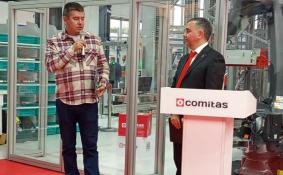Scientific & Practical Journal

Editorial News
Dear readers! We are pleased to present to you the eleventh issue of the journal in 2025. There are a lot of relevant and useful materials in the issue, which, hopefully, will not be ignored.
Dear readers! In September the CeMAT RUSSIA exhibition was held, which showed everyone that innovations and robotics are increasingly penetrating the logistics industry. We can safely say that many technologies are tested here, and only then they go out into the world. However, it is not only CeMAT RUSSIA that demonstrates the prevalence of the digital agenda.
Dear readers! This is the ninth issue of the journal, which turned out to be very rich and diverse. Traditionally, the issue is opened by an analyst. The material by Alina Nasyrova from the Market Guide Agency, dedicated to investments in warehouse complexes in Russia, recalls the importance of developing logistics infrastructure for the integrated development of regions.
PHOTO OF THE WEEK
CITATIONS
All News of Logistics
Supply Chain Strategy 2016
Now that holiday 2015 is behind us companies need to reflect back on 2015 and determine their supply chain strategy for holiday 2016 and beyond.
Delivery of goods continues to be a main component of the supply chain to focus on in 2016. Fortunately, holiday 2015 did not bring extremely harsh weather that could have greatly impacted the delivery of goods. Dr. Jim Tompkins, CEO, Tompkins International, “I cannot predict the weather, but I can explain the impacts of the weather and how companies can create a supply chain where weather predictions will not matter as much and customers will remain happy, companies must, get local.”
On-time delivery rates for 2015 versus on-time delivery rates for 2014,
FedEx performance held up well, UPS suffered a drop in on-time deliveries, as they continue to manage their costs, while increasing capacity for the seasonal peak. Luckily, there has not yet been a repeat of 2013.
The challenges have resulted not in the volume of dollars being shipped by companies but rather by the impact of smart phone orders. Smart phones have for the first time registered a significant volume of orders due to the fact that customers are placing smaller orders more often. As one click mobile checkout becomes more prevalent the order size will continue to shrink and thus more deliveries per dollar of sales will take place. Companies need to either have these orders shipped earlier to be sure of on-time delivery or they need the inventory to, get local. If the inventory becomes local, the area impacted by bad weather, website problems, or stocking issues will be significantly reduced.
A few facts regarding the volume of deliveries for holiday 2015:
- Over 1.3 billion packages were delivered in December 2015
- The big 3 in December were USPS at 42%, UPS at 32% and FedEx at 17%
- Other delivery companies at a record 9%
- Overall volume went up 9% over December 2014
- Cyber 5 performance for FedEx was 95% and UPS at 91% on-time delivery
- Overnight and two day - FedEx at 99% on-time performance and UPS at 96% on-time performance
Companies need to accept that there is a fixed capacity to delivery volume even with perfect weather. Companies cannot go after every last sale knowing there will be disappointed customers. Companies need to incentivize early online purchases and disincentivize last minute shopping with higher delivery fees. Companies need to deploy dynamic promotions to shape demand not to exceed system capacity. Companies need to manage the impact of weather disruptions by placing inventory local to customers and thus avoiding the catastrophes of hub shutdowns. The lesson that needs to be learned is inventory and deliveries must, get local, leaving the obsolete hub concepts out of final delivery.
Companies must understand the supply chain innovations taking place at Alibaba, Amazon, and Walmart. Simply stated by Dr. Tompkins, “if you respond you will be at a competitive advantage, if you do not respond you will lose customers, market share, and profitability.”
Dr. Tompkins’ newest thought leadership video The Titans: Alibaba, Amazon, and Walmart: Game Changing Strategies: Time For You To Respond was recently released and has received over 30,000 views. Dr. Tompkins continues to shape and grow the supply chain industry through innovative ideas, insight, and intelligence.










